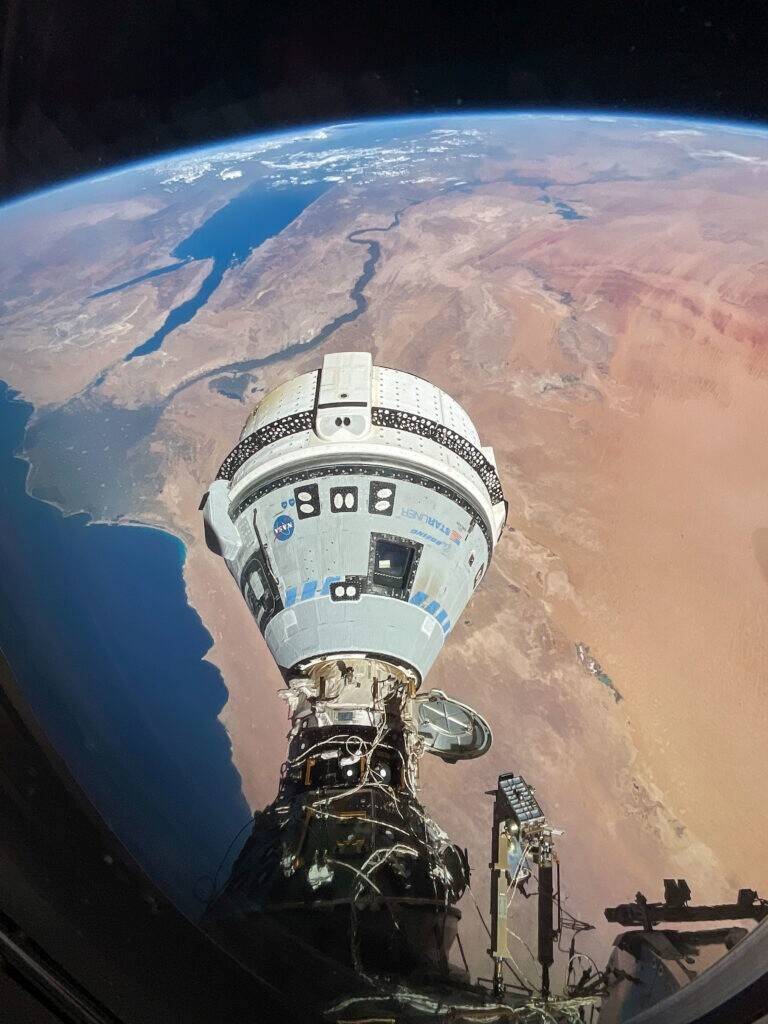In a significant restructuring of its Commercial Crew Program, NASA announced Monday that it is reducing the number of contracted Boeing Starliner missions to the International Space Station (ISS) and converting the spacecraft’s next planned flight from a crewed rotation to a cargo-only mission.

Boeing’s Starliner spacecraft docked to the ISS as it flies over Egypt in June 2024 during the Crew Flight Test. Credit: NASA
The revised plan marks the latest turn in Boeing’s long, troubled road toward certifying its CST-100 Starliner for operational crewed service. Under NASA’s original commercial crew contracts, both Boeing and SpaceX were to conduct an uncrewed demonstration flight, a crewed demo, and then six routine crew rotation missions.
While both companies completed their uncrewed test flights in 2019, their paths diverged sharply afterward. SpaceX advanced quickly, launching its successful Demo-2 crewed mission in May 2020 and completing 12 crewed NASA flights to date.
Boeing, meanwhile, was forced to repeat its uncrewed mission in 2022 after the first Orbital Flight Test failed to reach the station. The 2024 Crew Flight Test (CFT) later revealed serious issues—chiefly with Starliner’s thrusters—prompting NASA to order the spacecraft home without astronauts. The CFT crew ultimately returned to Earth aboard a SpaceX Dragon.
Starliner-1 Officially Recast as Cargo Mission
Following months of speculation, NASA confirmed that Boeing’s next mission, Starliner-1, will not carry astronauts. Instead, it will fly cargo to the ISS no earlier than April 2026.
“NASA and Boeing are continuing to rigorously test the Starliner propulsion system in preparation for two potential flights next year,” said Steve Stich, manager of NASA’s Commercial Crew Program. “This modification allows NASA and Boeing to focus on safely certifying the system in 2026, execute Starliner’s first crew rotation when ready, and align our ongoing flight planning for future Starliner missions through 2030.”
NASA has also reduced its minimum purchase commitment from six Boeing flights to four, with two optional. With Starliner-1 now uncrewed, NASA may have only three astronaut-carrying Starliner missions remaining. If Starliner-1 performs as expected, Boeing could finally fly astronauts operationally on Starliner-2—its first true crew rotation flight. NASA added that the next unassigned commercial crew flight is currently targeted for no earlier than October 2026, serving as the handover from SpaceX’s Crew-12.
Astronaut Assignments Thrown Into Flux
The shift leaves Boeing’s future astronaut lineup in limbo. Scott Tingle, originally named commander of Starliner-1, was recently appointed chief of NASA’s Astronaut Office—effectively removing him from the mission. Mike Fincke and JAXA astronaut Kimiya Yui, once assigned to Starliner-1, are now flying aboard SpaceX’s Crew-11. Canadian astronaut Joshua Kutryk was also slated to fly on Starliner-1. His status remains unclear.
Ars Technica reported that NASA astronaut Luke Delaney, who had begun training for Starliner-1, has since been reassigned to SpaceX’s Crew-13. Several astronauts with past Starliner training experience could be candidates for Starliner-2—if the cargo test succeeds. Nicole Mann, who trained for Starliner’s Crew Flight Test before shifting to SpaceX’s Crew-5, could be reconsidered. So too could Starliner CFT pilot Sunita “Suni” Williams, though her accumulated 600+ days in space may place her close to NASA’s radiation exposure limits.
With the Commercial Crew Program entering its next phase, the pressure is on Boeing to demonstrate reliability after years of setbacks. NASA has signaled continued support—but a more measured, risk-managed approach. All eyes will now be on the cargo-only Starliner-1 mission in 2026, a pivotal step in determining whether Boeing’s spacecraft can finally join SpaceX’s Dragon in routine crew rotation service to the International Space Station.


Add comment
Comments